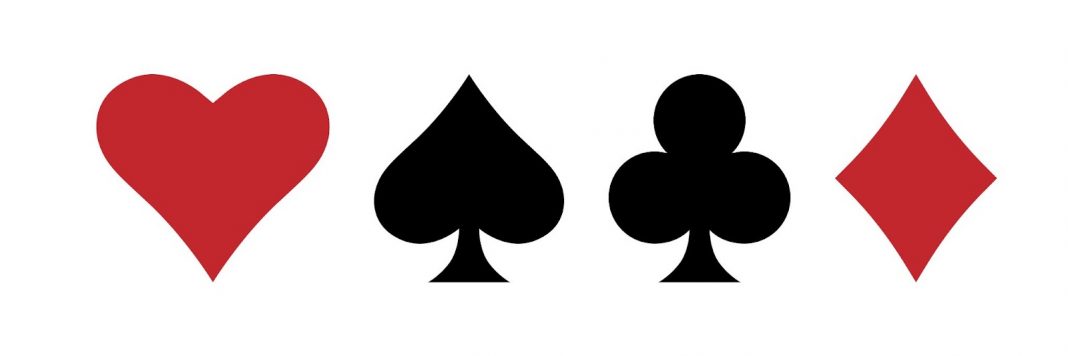Research shows a notable gap in early math skills between low-income preschoolers and their middle-income counterparts. A study in the National Library of Medicine reveals that math card games can be a game-changer in this scenario. This research, involving 76 low-income preschoolers, demonstrated that playing numerical card games significantly improved their numeral identification and symbolic magnitude comparison skills. Impressively, these benefits lasted for at least eight weeks post-intervention.
Math & ELA | PreK To Grade 5
Kids see fun.
You see real learning outcomes.
Watch your kids fall in love with math & reading through our scientifically designed curriculum.
Parents, try for free Teachers, use for free
The study highlights how math card games not only enhance early numeracy skills, crucial for later arithmetic success but also bolster executive functioning skills like working memory and cognitive flexibility. These findings underscore the importance of integrating fun, educational games into early learning, especially for children from diverse socioeconomic backgrounds.
In this blog, we’ll explore some of the fun card games for kids that are not just fun but are also powerful tools for enhancing your child’s math skills. From addition and subtraction to fractions and decimals, these games cover a wide range of mathematical concepts suitable for various age groups.
5 Addition & Subtraction Card Games
Addition and subtraction are foundational skills every child needs to master. These basic operations are the building blocks for more complex math concepts. Through this list of card games on addition & subtraction, kids can practice these essential skills in a playful and engaging environment, turning learning into an enjoyable experience.
1. Addition Pyramid
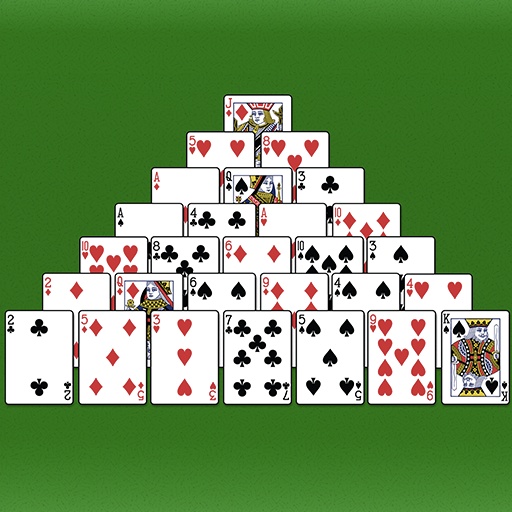
Addition Pyramid is a fun and engaging card game that combines strategy with basic addition skills. It’s perfect for kids who enjoy puzzles and number challenges.
How to Play: Players arrange cards in a pyramid shape and add two adjacent cards to fill the next card above. The game continues until the pyramid is complete or no more moves are possible.
Age Range: 6-10 years
Number of Players: Single player card game
Objective: To complete the pyramid by correctly adding adjacent numbers.
Materials Needed: A standard deck of playing cards (remove face cards).
2. Addition War
This is one of the easy card games where players learn addition in a fun, competitive format. It’s a twist on the classic game of War, using addition to determine the winner of each round.
How to Play: Each player turns over two cards, and adds their values, and the player with the higher sum wins the round. The game continues until all cards are played.
Age Range: 5-9 years
Number of Players: 2 (card games for two)
Objective: To win the most rounds by having the highest sum of two cards.
Materials Needed: A standard deck of playing cards.
3. Make Ten
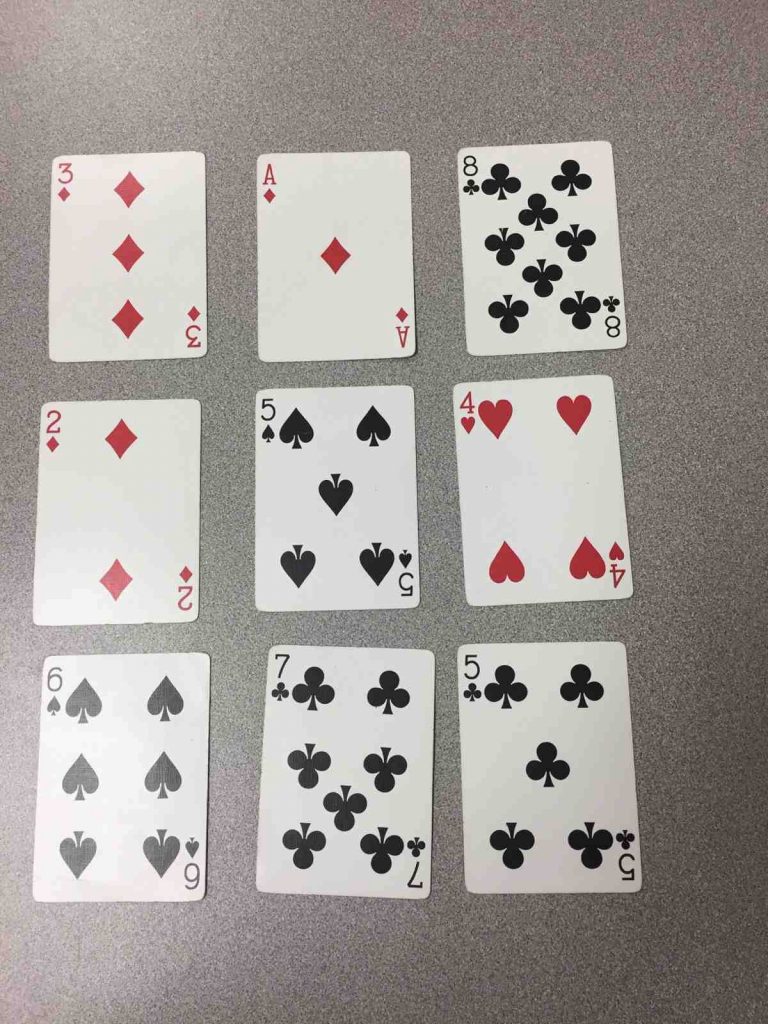
Make Ten is a simple yet exciting game that helps kids master the concept of making ten using different number combinations.
How to Play: Players take turns drawing cards, trying to pair cards that add up to ten. The game ends when all possible pairs are made.
Age Range: 4-8 years
Number of Players: 2 or more
Objective: To make as many pairs of cards that total ten.
Materials Needed: A standard deck of playing cards (remove face cards).
4. Subtraction Match-Up
Subtraction Match-Up is an educational game where players practice their subtraction skills in a matching card format.
How to Play: Players lay cards face down and take turns flipping two cards, subtracting the smaller number from the larger one. If the result matches a predetermined number, they keep the pair.
Age Range: 6-10 years
Number of Players: 2 or more
Objective: To collect the most pairs by correctly subtracting numbers.
Materials Needed: A standard deck of playing cards.
5. Gain or Loss
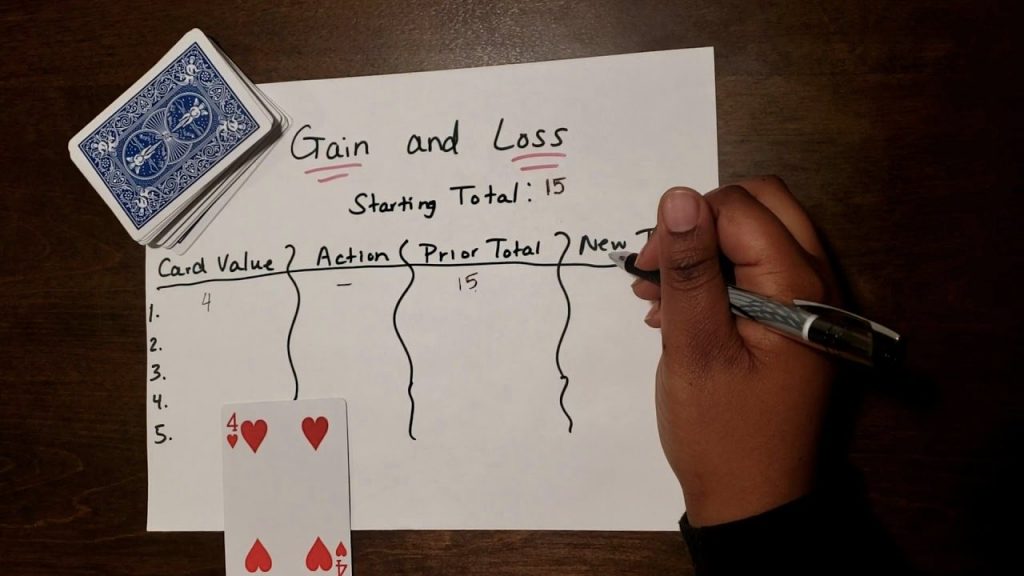
Gain or Loss is a dynamic game that introduces basic arithmetic operations through a fun and interactive approach.
How to Play: Players draw cards and decide to either add or subtract the values from a running total. The player who reaches a set target number first or stays closest after a set number of rounds wins.
Age Range: 7-12 years
Number of Players: 2 or more
Objective: To reach or be closest to the target number through addition and subtraction.
Materials Needed: A standard deck of playing cards.
Ready to make math fun and interactive for your child? If you’re looking for engaging ways to help your kids master addition and subtraction, here are some free addition games and Subtraction games to get started:
5 Multiplication and Division Card Games
Multiplication and division are crucial steps in a child’s mathematical education, forming the basis for understanding more advanced topics. These easy card games on multiplication and division make these concepts approachable and fun. By integrating these skills into gameplay, children can learn and reinforce their knowledge in a way that feels like play, not work.
6. Division War Game
Division War Game is a fun twist on the classic War game, making it a fun card game for kids to practice division skills.
How to Play: Each player flips two cards, dividing the larger number by the smaller one. The player with the highest quotient wins the round.
Age Range: 8-12 years
Number of Players: 2
Objective: To win the most rounds by having the highest quotient.
Materials Needed: A standard deck of playing cards (remove face cards).
Related Reading: Best Multiplication Tricks for Math Students
7. Turnover
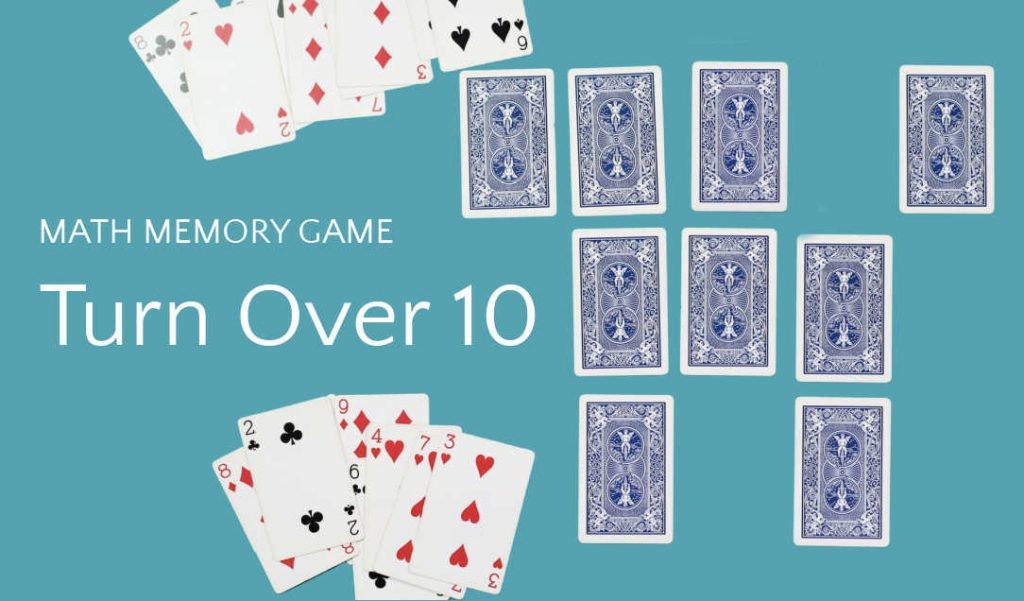
Turnover is one of the creative math card games with cards that combines luck and skill in practicing multiplication.
How to Play: Players take turns flipping over two cards and multiplying their values. If the product matches a predetermined number, they keep the cards.
Age Range: 7-11 years
Number of Players: 2 or more
Objective: To collect the most pairs by correctly multiplying numbers.
Materials Needed: A standard deck of playing cards.
8. Once Through the Deck
Once through the deck is one of the most fun card games with a deck of cards. This game challenges players to use their division and multiplication skills as they work through the deck.
How to Play: Players go through the deck, drawing one card at a time and either multiplying or dividing it with a running total.
Age Range: 9-13 years
Number of Players: Single player or more
Objective: To practice multiplication and division skills in a timed challenge.
Materials Needed: A standard deck of playing cards.
Related Reading: How to Teach Multiplication to Kids
9. Multiplication War
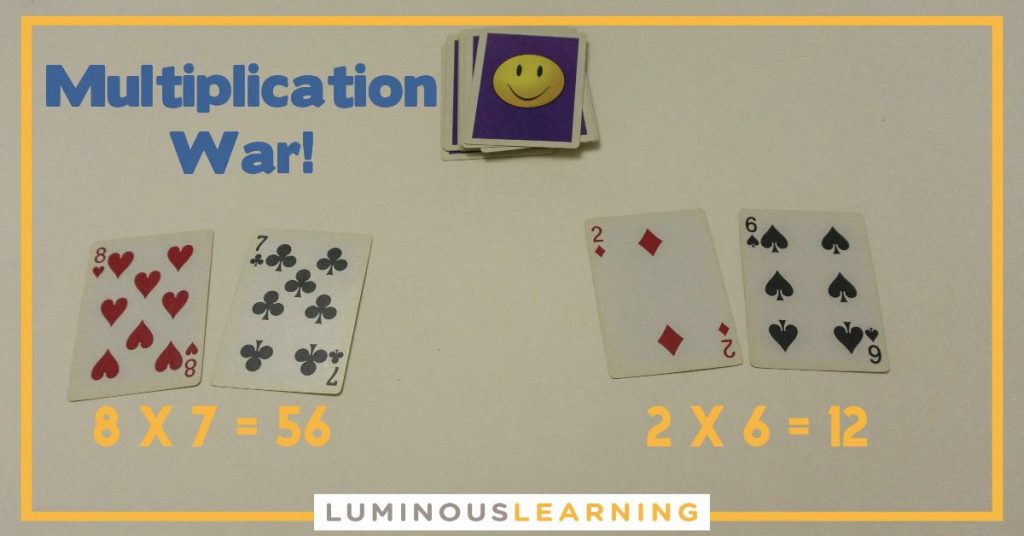
Multiplication War is a simple yet engaging game where players compete to have the highest product, making it a fun card game idea for kids.
How to Play: Similar to Division War, but players multiply the values of the two cards they flip. The highest product wins the round.
Age Range: 7-12 years
Number of Players: 2
Objective: To win the most rounds by having the highest product.
Materials Needed: A standard deck of playing cards.
10. Division Bingo
Division Bingo combines the excitement of Bingo with division practice, making it a fun and educational game for kids.
How to Play: Players create Bingo cards with numbers. A caller draws cards and announces division problems. Players mark off the answers on their Bingo cards.
Age Range: 8-12 years
Number of Players: 2 or more
Objective: To be the first to complete a row, column, or diagonal on their Bingo card.
Materials Needed: Bingo cards with numbers, a standard deck of playing cards for drawing division problems.
Eager to boost your child’s multiplication skills in a way that’s both fun and effective? Start exploring these multiplication games today and witness a remarkable improvement in their math abilities.
5 Number Sense and Place Value Card Games
Understanding numbers and their values is a key aspect of early math education. It’s not just about counting, but also about recognizing the significance of a number in different contexts. These number sense and place value card games are designed to strengthen these fundamental concepts through interactive and enjoyable activities, helping children grasp the importance of numbers in a practical and engaging manner.
11. Place Value Bingo
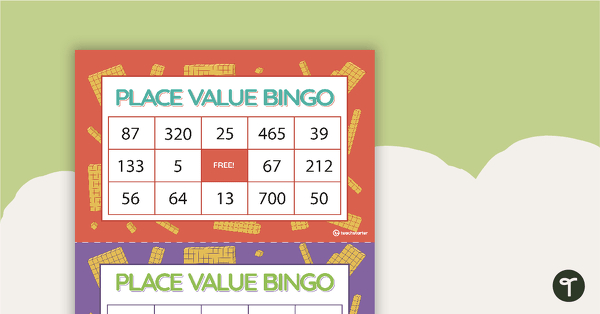
Place Value Bingo is a fun and interactive way to help kids understand place values, making it a great addition to math card games for kids.
How to Play: Players create Bingo cards with numbers in different place values. A caller draws cards and calls out numbers in terms of place value. Players mark off the corresponding number on their cards.
Age Range: 6-10 years
Number of Players: 2 or more
Objective: To be the first to complete a row, column, or diagonal on their Bingo card.
Materials Needed: Bingo cards with numbers, a standard deck of playing cards for drawing numbers.
12. Hold the Line
Hold the Line is one of the most simple card games for kids that reinforces the concept of number order and place value.
How to Play: Players take turns drawing cards and placing them in a line in numerical order. The game becomes challenging as the line grows and space becomes limited.
Age Range: 5-9 years
Number of Players: 2 or more
Objective: To successfully place all your cards in the correct numerical order.
Materials Needed: A standard deck of playing cards (remove face cards).
13. Place Value Game (with rounding)
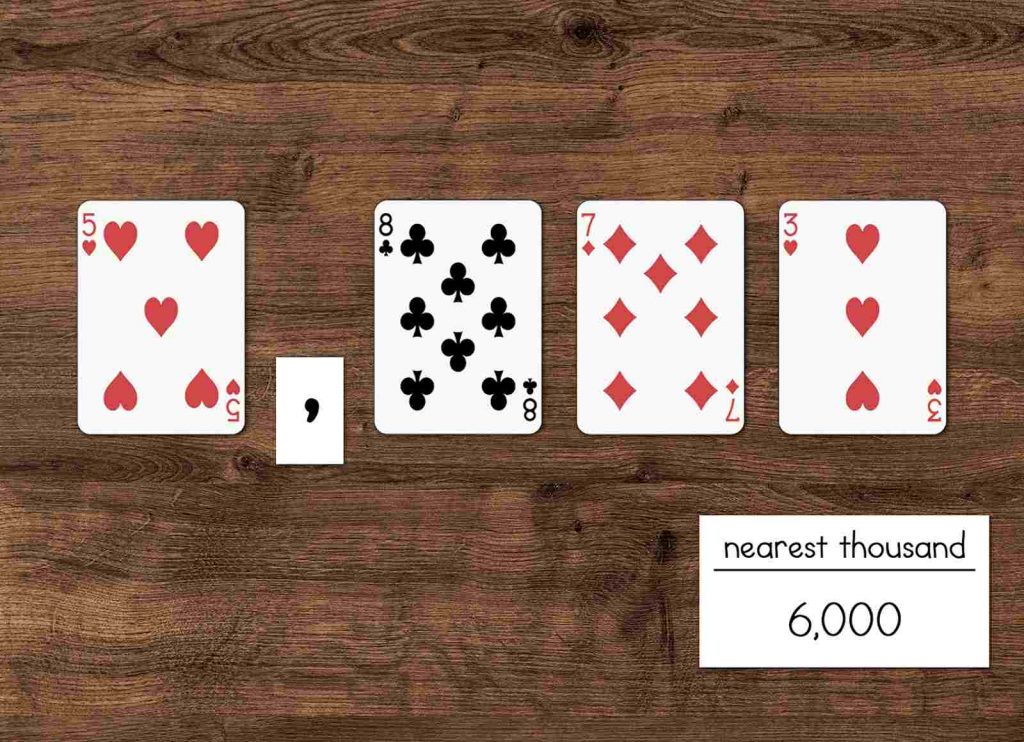
This game introduces children to rounding numbers and understanding place values, making it a valuable addition to the list of math games with playing cards.
How to Play: Players draw cards and decide where to place them in a number grid to form the highest possible number. They then practice rounding these numbers to the nearest ten, hundred, etc.
Age Range: 7-11 years
Number of Players: 2 or more
Objective: To create and round off the highest possible number.
Materials Needed: A standard deck of playing cards, and paper for creating number grids.
14. Triple Digit Dare
Triple Digit Dare is an exciting game that challenges kids to create the highest three-digit number, enhancing their understanding of place value.
How to Play: Players draw cards and strategically place them in a three-digit grid. The player with the highest number at the end of the game wins.
Age Range: 8-12 years
Number of Players: 2 or more
Objective: To form the highest possible three-digit number.
Materials Needed: A standard deck of playing cards, paper for creating grids.
15. Place Value Match-Up
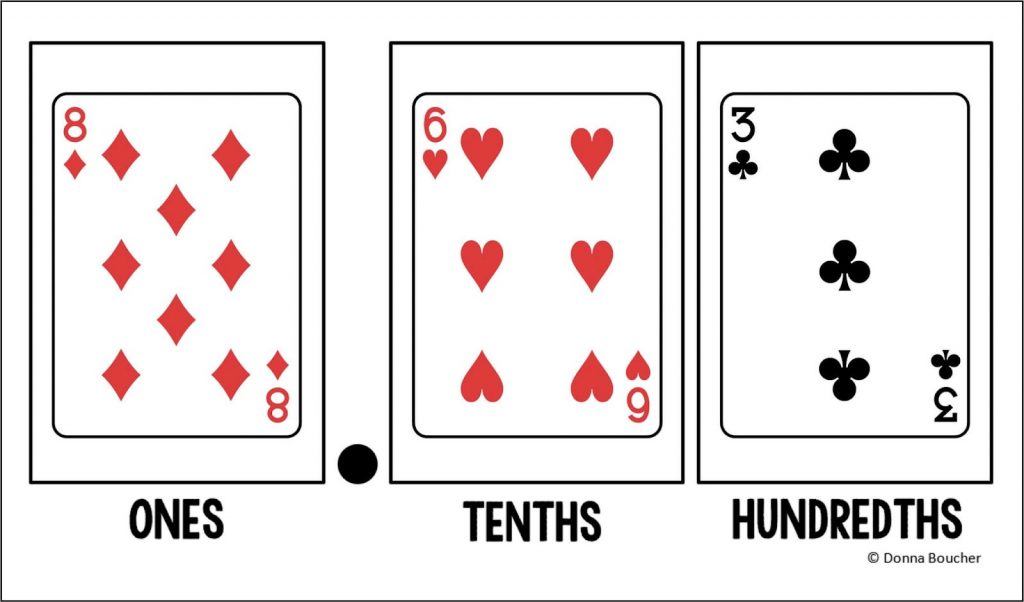
Place Value Match-Up is a matching game that helps kids solidify their understanding of place values in a fun and engaging way.
How to Play: Cards are laid face down, and players take turns flipping two cards, trying to match numbers with the same place value.
Age Range: 6-10 years
Number of Players: 2 or more
Objective: To collect the most pairs of cards with matching place values.
Materials Needed: A standard deck of playing cards (remove face cards).
Nurturing number sense early on is crucial for a child’s mathematical development. It lays the groundwork for understanding more complex concepts later in life. Here are some games to help your child on this journey:
6 Fractions and Decimals Card Games
Fractions and decimals can often be challenging topics for young learners, yet they are vital for their mathematical development. Fractions and decimals card games introduce these concepts in a friendly and accessible way. By incorporating these topics into card games, we provide a platform for children to explore and understand fractions and decimals in a setting that encourages learning through play.
16. My Closest Neighbor
My Closest Neighbor is one of the most fun educational card games that helps kids understand and compare fractions in a fun and interactive way.
How to Play: Players draw cards and place them on a number line, trying to get their fractions as close as possible to a target fraction.
Age Range: 9-13 years
Number of Players: 2 or more
Objective: To place fractions closest to the target fraction.
Materials Needed: A standard deck of playing cards, paper to create a number line.
17. Fraction Flip It (multiplying fractions)
This game makes multiplying fractions engaging, turning a challenging concept into an enjoyable activity.
How to Play: Players flip two cards, convert them into fractions, and multiply. The player with the highest product after a set number of rounds wins.
Age Range: 10-14 years
Number of Players: 2 or more
Objective: To practice multiplying fractions and get the highest product.
Materials Needed: A standard deck of playing cards.
Related Reading: How to Multiply & Divide Fractions: Steps With Visual Models
18. Fraction Bingo
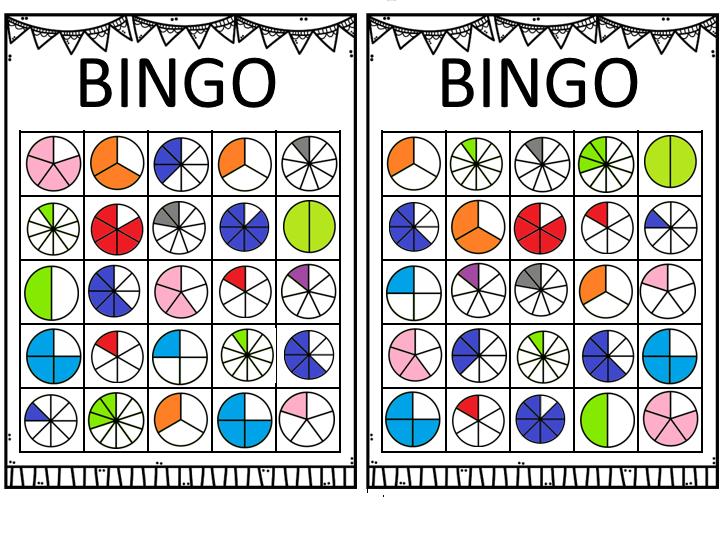
Fraction Bingo is a fun way to practice fraction recognition and conversion, making it a great option if you are looking for number card games for kids.
How to Play: Players create Bingo cards with fractions. A caller draws cards and calls out fractions or equivalent decimals. Players mark off the corresponding fraction on their cards.
Age Range: 8-12 years
Number of Players: 2 or more
Objective: To be the first to complete a row, column, or diagonal on their Bingo card.
Materials Needed: Bingo cards with fractions, a standard deck of playing cards for drawing fractions.
19. Declare a Fraction War
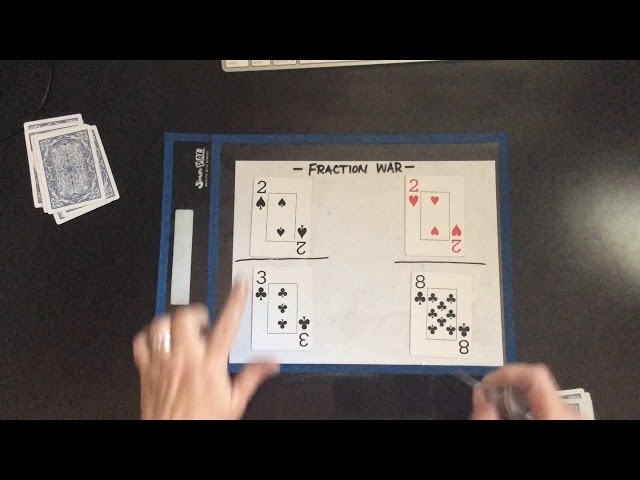
Declare a Fraction War is a twist on the classic War game, using fractions to determine the winner of each round.
How to Play: Each player flips two cards, creating a fraction. The player with the larger fraction wins the round.
Age Range: 9-13 years
Number of Players: 2
Objective: To win the most rounds by having the larger fraction.
Materials Needed: A standard deck of playing cards.
20. Decimal War
If you are looking for simple and engaging math games to play with cards then Decimal War is a great option. This game focuses on comparing decimal values.
How to Play: Similar to Fraction War, but players convert their two cards into a decimal. The player with the higher decimal value wins the round.
Age Range: 10-14 years
Number of Players: 2
Objective: To win the most rounds by having the higher decimal value.
Materials Needed: A standard deck of playing cards.
21. Simple Simon Fractions Race (Simplifying Fractions)
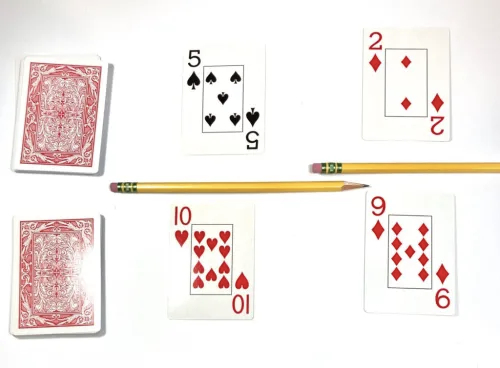
This game encourages kids to practice simplifying fractions in a race against time or opponents.
How to Play: Players draw cards and form fractions, then race to simplify them as quickly as possible.
Age Range: 9-13 years
Number of Players: 2 or more
Objective: To be the fastest at simplifying fractions.
Materials Needed: A standard deck of playing cards.
Fraction is essential for grasping more advanced math concepts later on. To make learning fractions engaging and accessible, here are some interactive fraction games:
Related Reading: Best Math Board Games for Kids
5 Benefits of Math Card Games
Drawing from a compelling study published in the National Library of Medicine, math card games emerge as a powerful tool in bridging the early numeracy skills gap, especially for children from low-income backgrounds. This study highlights several key benefits:
- Improvement in Numerical Skills: The study found that children who played numerical card games showed significant improvements in numeral identification and symbolic magnitude comparison skills. These skills are foundational for arithmetic understanding and predict mathematical achievement in later grades.
- Sustained Learning: Remarkably, the improvements gained from these card games persisted for at least eight weeks after the intervention, suggesting that the benefits of such games are not just immediate but also enduring.
- Executive Functioning Skills: Playing these games also enhanced children’s executive functioning skills, which include critical abilities like working memory and cognitive flexibility. These skills are not only important in mathematics but are essential for overall cognitive development.
- Accessible and Low-Cost: These card games are a low-cost, effective educational resource. This makes them particularly valuable for low-income families and educators looking for affordable ways to boost children’s numeracy skills.
- Engaging and Fun: Beyond their educational value, these games are engaging and enjoyable, making learning a fun and interactive experience for children.
Related Reading: Why Math Is Important for Kids: Top 10 Reasons
Conclusion
We hope this list of math card games inspires you to turn learning into an exciting adventure for your kids. These games are not just a way to pass the time; they’re a bridge to building stronger math skills and boosting cognitive development in a fun, engaging manner. So, grab a deck of cards and start playing – the journey towards making math enjoyable and impactful for your children begins here!
Related Reading: Best Math Games for Kids That Are Fun to Play
Frequently Asked Questions (FAQs)
What age group are these math card games suitable for?
These math card games cater to a wide range of ages, typically from 4 to 14 years old. Each game is designed to suit different age groups, ensuring that the math challenges are age-appropriate and engaging.
Can these card games really improve my child’s math skills?
Absolutely! These games are not only fun but also educational. They help improve basic arithmetic, number sense, and cognitive skills like memory and strategic thinking, as supported by educational research.
Do I need special cards to play these math games?
No, most of these games can be played with a standard deck of playing cards. Some games may require additional materials like paper for scorekeeping or creating grids, but nothing beyond simple household items.

















